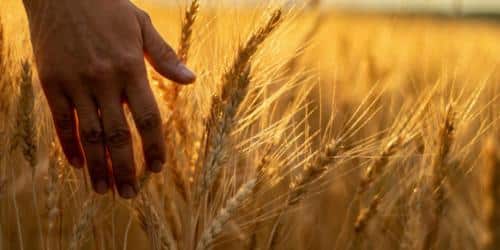If you consume bread or noodles on a regular basis, you are reliant on wheat as a dietary staple. Interestingly, this does not only apply to you; many Nigerian families rely on wheat products as a staple in their diet. Wheat farming is the cultivation of wheat. Wheat farming encompasses all of the procedures involved in wheat cultivation. In this article, we will go over all there is to know about wheat farming, including how to get started. Let’s get started!
What Is Wheat?
Wheat is a cereal grain from the genus Triticum that is commonly grown for its very nutritious seeds. Triticum aestivum is its scientific name. Wheat is one of Nigeria’s and Africa’s most significant staple crops, and it is used for a variety of products such as bread, pasta, and porridge.
Origin
According to Wikipedia, “the archaeological record indicates that wheat was first cultivated in the Fertile Crescent regions around 9600 BCE.”
The term “cultivation” refers to the act of growing something. Farmers preferred mutant forms of wheat, therefore repeated cultivation and harvesting of the grains of wild grasses resulted in the production of domestic strains.
What Is Wheat Farming In Nigeria?
Wheat farming, often known as wheat cultivation, refers to the production of wheat crops for human consumption or animal feed. Triticum aestivum is the scientific name for wheat. Due to the strong demand for wheat products in Nigeria and Africa, wheat farming is a key agricultural practice. In Nigeria and Africa, research has been performed to increase the productivity and quality of wheat crops, such as the development of novel wheat varieties that are more resistant to diseases and pests.
In Nigeria and Africa, wheat farming includes preparing the soil, planting the seeds, and providing proper care to the crops, such as irrigation, fertilizer application, and weed control. Wheat crop production after farming varies according to environmental circumstances, crop management strategies, and wheat variety used. The average production of wheat crops in Nigeria is 1.5-2 tons per hectare, however, in other African nations such as Ethiopia and Egypt, the yield can reach 4-5 tons per hectare.
Wheat farming supports Nigeria and Africa in a variety of ways, including job generation, food security, and economic progress. Nigeria, for example, has the potential to become a significant wheat exporter, particularly to other African countries. Nigeria and Africa may enhance their output yield and become key players in the global wheat market by investing in research and development, developing infrastructure, and offering assistance to wheat farmers.
Wheat Varieties Used in Nigerian Wheat Farming
Wheat farming is a significant agricultural activity in Nigeria and throughout Africa. This Wheat varieties used for wheat farming in Nigeria and Africa include:
- Hard Red Winter Wheat: Because of its high protein content, hard red winter wheat is used to make bread and all-purpose flour.
- Hard Red Spring Wheat: This type of wheat is also used to make bread and is primarily grown in Nigeria’s northern states.
- Soft Red Winter Wheat: This wheat has a reduced protein content and is commonly utilized in the production of cakes, pastries, and biscuits.
- Durum Wheat: Durum wheat is a high-protein wheat that is commonly used to make pasta, couscous, and bulgur.
- White Wheat: White wheat has a lighter hue and a sweeter flavor than red wheat. It is used to make cakes, pastries, and cookies.
- Club Wheat: Club wheat is a soft, low-protein wheat that is commonly used to make crackers and flatbreads.
- Spelled: Spelt is an ancient grain that is becoming increasingly popular in Nigeria and Africa due to its health benefits. It is suitable for baking bread, pasta, and cereal.
- Kamut: Kamut is an ancient grain with a nutty flavor that is used to make bread and pasta.
Each variety of wheat has distinct features and is best suited for specific applications. Farmers must select the appropriate wheat variety depending on end-use and environmental parameters such as soil type, temperature, and rainfall.
Health Benefits of Wheat
There are certain benefits to using a wheat grinder, such as the ability to save time and money. Here we will discuss the several health benefits of eating wheat.
- Wheat is an excellent source of carbohydrate and it is also a high source of protein.
- Wheat is a good source of fiber and it improves metabolism.
- Wheat is a very good source of manganese and magnesium.
- Wheat provides us with some amount of essential amino acids.
- Wheat is a great source of multiple nutrients when eaten as a whole grain.
How to Start Wheat Farming
To ensure a successful endeavor, starting wheat farming in Nigeria and Africa involves appropriate strategy and implementation. The following is a step-by-step method to getting started in wheat farming:
#1. Select a Good Location
You must choose a decent place with fertile soil for wheat farming. The optimal soils for wheat farming include a clay loam or loam texture, good structure, and moderate water-holding ability.
You can also choose a spot with thick soil and a good drainage system (if the weather is dry). When selecting land for wheat farming, keep all of these things in mind.
#2. Prepare the Soil
You must meticulously prepare the soil for wheat farming. Using a disc or moldboard plow, plow the dirt.
Prepare the soil by plowing it deeply once with an iron plow, then light plowing and planking 2-3 times. After plowing, 2-3 harrows will be quite useful for soil preparation. Plowing should be done first thing in the morning, and planking should be done after each plowing.
While preparing the soil, use all natural and chemical fertilizers. The precise amount of chemical fertilizers required is determined through soil testing.
An average of 50 kg Nitrogen, 25 kg Phosphorus, and 12 kg Potash per acre will suffice for commercial wheat farming. And, while preparing the soil, incorporate as much organic matter as possible.
#3. Climate Requirements for Wheat Farming
Wheat plants are adaptable to a wide range of agro-climatic situations. The plants are highly adaptable, and they may be grown in the tropical and subtropical zones, as well as the temperate zone and the far north.
The majority of the time, the majority of the time, the majority of the time.
Wheat plants can be planted from sea level to 3300 meters in height. However, the best climate for wheat farming is one that is damp and cool. Wheat farming is viable across a wide temperature range. The plants can withstand temperatures ranging from 3.5 to 35 degrees Celsius, but the ideal temperature for wheat farming is between 21 and 26 degrees Celsius.
#4. Best Time for Wheat Farming
Wheat can be produced at any time of year as long as the weather is cooperative and the temperature ranges between 3.5 °C and 35 °C (however the ideal temperature range for wheat farming is between 21 °C and 26 °C).
#5. Choose a Variety
There are numerous different types and varieties of wheat that can be found in the world. In addition, there are numerous varieties accessible in different places.
In terms of traits and yield, each of these cultivars is unique. Hexaploid species include spelled, durum, emmer, einkorn, Khorasan, and common wheat or bread wheat.
Some of the classifications used in the United States are durum, hard white, soft white, hard red spring, hard red winter, and soft red winter. In some locations, there are also several hybrid or high-yielding wheat varieties available.
#6. Purchase Seeds
Wheat is widely grown and consumed around the world. As a result, the seeds should be readily available in your area.
Visit your local government or private seed source. Also, while purchasing seeds, try to purchase high-yielding, disease-free seeds from local seed suppliers.
#7. Seeds per Acre
In general, 40-50 kg of seeds are needed per acre. However, the exact number of seeds needed depends on the cultivar and sowing method.
#8. Planting
Wheat seeds can be seeded in a variety of ways. The usage of a ton of different tools, such as a drill, a syringe, and a camera, is a common practice in the industry.
Sow the seeds approximately 4-5 cm deep. Planting the seeds in rows will be beneficial. Rows should be roughly 20-22.5 cm apart. Planting or spreading the seeds at the proper time is critical in wheat farming.
The amount of time it takes to do a task is determined by the number of times it is done. Late October to November is regarded as the optimal time for wheat farming in Indian agro-climatic conditions. Before sowing, the wheat seeds should be evaluated and carefully cleaned. Fungicide can be used to treat the seeds.
#9. Caring
The majority of the time, the term “soil” refers to the soil. They generally thrive in favorable conditions and require little attention. Although adopting extra precautions will benefit wheat farming and assure optimal production.
More information regarding plant care for successful wheat farming can be found here.
- Fertilizing: Additional fertilizer is not required if the soil has been prepared in the ways described above.
- Watering: The term “water” refers to the process of obtaining and storing water. The first irrigation should take place 20-25 days after the seeds are planted. After the previous irrigation, an additional 4-5 irrigations should be performed every 20-25 days.
- Weed Control: You can control most weeds in your field by eliminating them while preparing the soil. Furthermore, further weeding is required. Chemicals can also be used to control weeds.
#10. Pests and Diseases
Wheat plants are vulnerable to a variety of pests and diseases. Aphids and termites are frequent wheat plant pests. Diseases that affect wheat plants frequently include brown rust, powdery mildew, flag smut, Karnal bunt, and yellow or stripe rust.
Please check with your local agriculture extension office or any specialist for improved pest and disease control recommendations.
#11. Harvesting
Harvesting will begin when the leaves and stems turn yellow and become somewhat dry. The term “dead” refers to the process of a person’s death from a disease. As a result, timely harvesting is critical to ensuring maximum grain quality.
When the moisture level of the grain reaches about 25 to 30 percent, the wheat is ready to harvest. Serrate sickles, on the other hand, can be used for manual harvesting. After all of the operations are completed, store the harvested grain in a secure location.
#12. Yield
The precise amount varies according to the variety and a number of other factors. However, you might expect up to 2 tons per acre on average.
Is Wheat Farming Profitable?
Yes, commercial wheat production is an extremely profitable enterprise. You can start this business for profit. However, before beginning commercial production, you need to establish the market demand and worth of your product. First, try to ascertain the price and demand in your local market.
How to Start Wheat Farming Business?
It is relatively simple to begin commercial wheat production. Without prior experience, you can begin cultivating wheat. First and foremost, choose a suitable area for your production, prepare the soil, add necessary nutrients or fertilizer to the soil, plant seeds, irrigate the soil, and care for the plants.
What is the Best Way to Farm Wheat?
Plow the soil thoroughly and apply enough organic fertilizer during the final plowing. Plant wheat seeds in the furrows with a semi-circular movement of your wrist or by attaching a grain drill to a tractor. Sprinkle a little amount of seeds on a dry area.
Is Wheat Easy to Farm?
Wheat is a simple crop to grow. It’s similar to rice farming. The majority of the time, the majority of the time, the majority of the time, the majority of the time.
Does Wheat Need a Lot of Water?
No, water requirements for wheat cultivation are lower than for many other crops.
What Happens to Wheat if it is Not Harvested?
Delaying wheat harvest increases the danger of illness, lodging, sprouting, and harvest loss.
What Conditions Does Wheat Need to Grow?
Plants require healthy soil and low soil temperatures (high soil temperatures might inhibit plant establishment). The optimal temperature range for wheat germination is 12°-25°C, but germination can occur at temperatures ranging from 4° to 37°C.
Conclusion
To summarize, wheat farming is a profitable and viable agricultural endeavor in Nigeria and throughout Africa. There is a considerable demand for wheat products both locally and internationally, providing farmers with possibilities to explore new ways to sell and market their products.
Wheat farming in Nigeria and Africa faces a number of obstacles, including inadequate infrastructure, limited access to funding, and weak market links. These obstacles, however, can be addressed with effective planning, adequate research, and appropriate management methods.
Related Articles
- Dates Farming: Best Beginners Guide 2023
- HARVEST TIME TRACKER: Harvest Software Reviews & Pricing 2023
- BREAD BRANDS: 2023 Healthiest Options & All You Need
- SEED FUNDING FOR STARTUPS: A Complete Guide
- RETENTION RATIO: How to Calculate it with Examples






